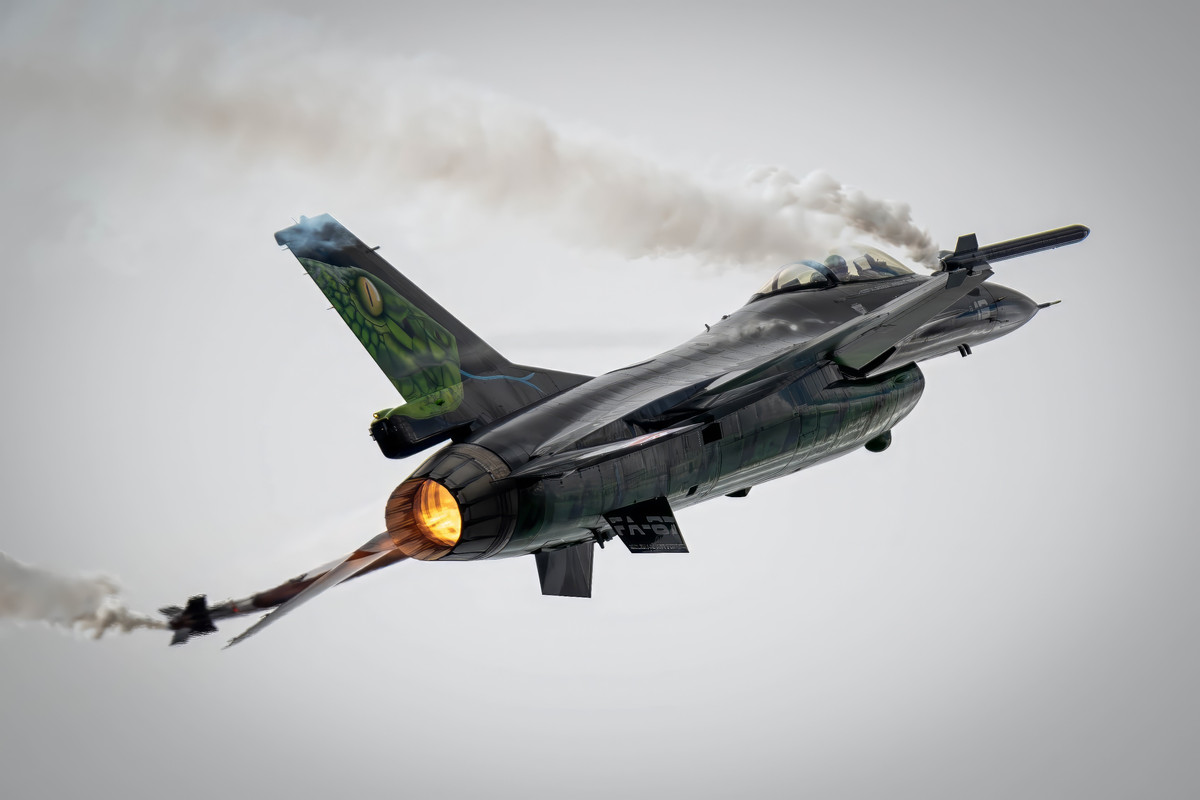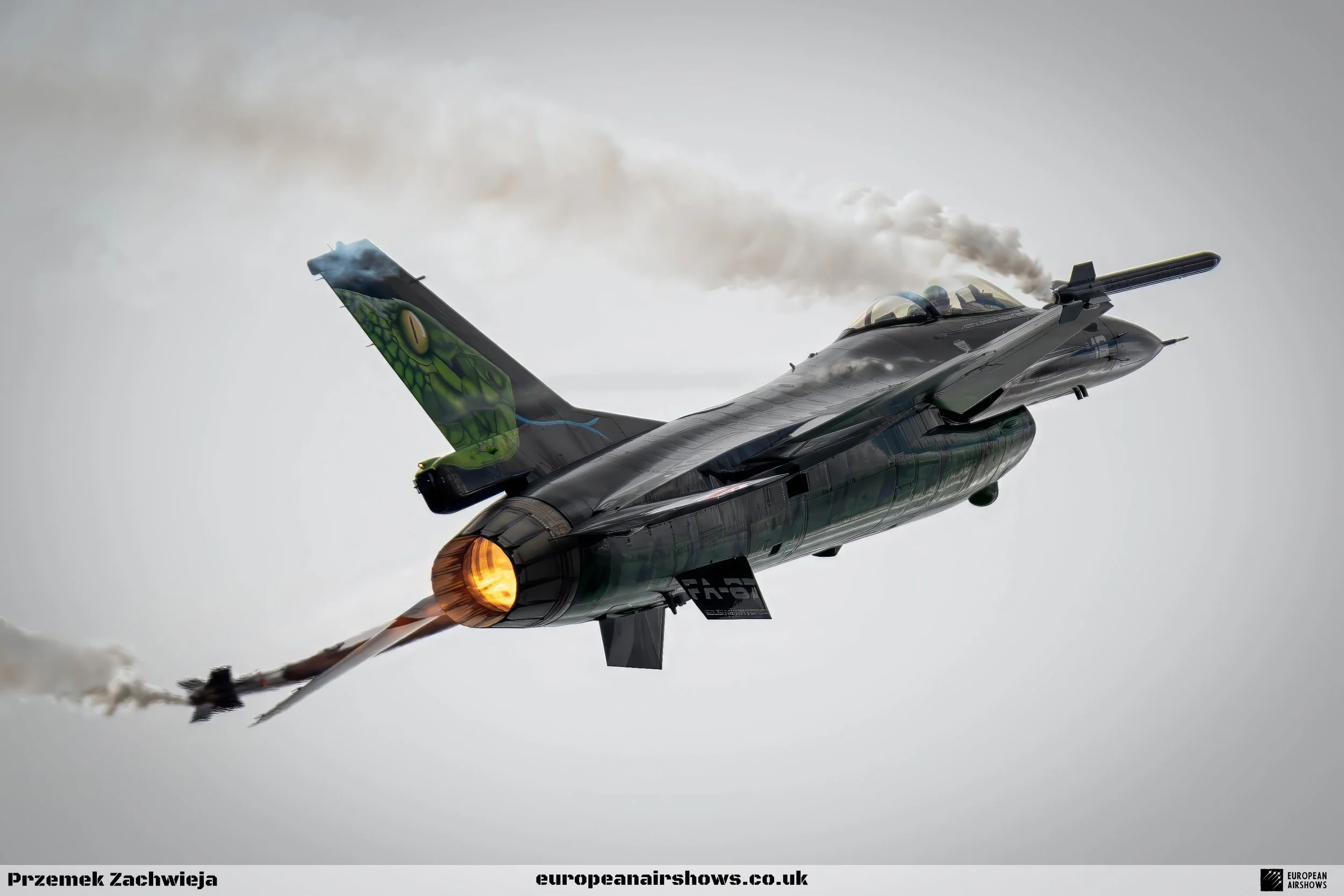
Belgian Air Force F-16 Solo Display Team
About the Aircraft
The F-16 Fighting Falcon is a single-engine, multi-role fighter aircraft developed by General Dynamics (now Lockheed Martin) for the United States Air Force. First introduced in the late 1970s, it is known for its versatility, agility, and advanced avionics. The F-16 can perform a variety of missions, including air-to-air combat, air-to-ground strikes, and reconnaissance. It features a frameless bubble canopy for improved visibility, a side-mounted control stick, and a high thrust-to-weight ratio, allowing for exceptional maneuverability. The aircraft has been widely exported and remains one of the most popular fighter jets in the world, serving in numerous air forces globally.
Specifications
Crew
1 F-16C / 2 F-16D
Length
49 ft 5 in (15.06 m)
Wingspan
32 ft 8 in (9.96 m)
Height
16 ft (4.9 m)
Max Speed
Mach 2.05 (2,178 km/h; 1,353 mph; 1,176 kn)
Combat Range
295 nmi (339 mi, 546 km)
Service Ceiling
50,000 ft (15,000 m)
Thrust/weight
1.095
Historical Development
The F-16 Fighting Falcon was developed by General Dynamics in the 1970s as part of the U.S. Air Force’s Lightweight Fighter program. The YF-16 prototype first flew in 1974, and the aircraft entered service in 1978. Known for its agility and versatility, the F-16 has undergone numerous upgrades and has been widely exported, serving in over 25 countries and participating in various conflicts worldwide. Its design features advanced avionics and a digital fly-by-wire system, making it one of the most successful fighter jets in history.
Did You Know?
- The F-16 Fighting Falcon, originally designed as a day fighter for air superiority, has evolved into a versatile multirole aircraft, with over 4,600 units built since its introduction in 1976.
- Known as the “Viper,” the F-16 features a frameless bubble canopy for enhanced visibility and a side-mounted control stick, allowing pilots to maneuver more easily during combat.
- The F-16 is equipped with a powerful single turbofan engine that can produce up to 29,500 pounds of thrust with afterburner, enabling it to reach speeds of Mach 2.05 at high altitudes.
- As of 2024, the F-16 is the world’s most common fixed-wing military aircraft, with 2,145 operational units, serving not only in the U.S. Air Force but also in the air forces of 25 other nations.
- The aircraft’s advanced avionics include the AN/APG-68 radar, which is being upgraded to the AN/APG-83 AESA radar, enhancing its capabilities in detecting and tracking targets in various combat scenarios.
Test Your Knowledge
Performer Information
The origins of the Belgian F-16 Solo Display team can be traced back to a remarkable initiative in 1980, coinciding with the introduction of the F-16 Fighting Falcon into the Belgian Air Force’s fleet. The first aircraft, a prototype F-16B Block 1 known as FB-01, was meticulously assembled by SABCA and officially handed over to the Belgian Air Force in January 1980, marking the beginning of a new era in aerial demonstrations.
In a bold move to showcase Belgium’s advanced capabilities, the Belgian Air Force launched the F-16 Solo Display team shortly after the aircraft’s operational debut. The inaugural display was piloted by Major Jozef “Jef” De Heyn, a visionary aviator who would later rise to become the commander of Kleine-Brogel air base and serve as Belgium’s defense attaché in the United States. Major De Heyn’s dynamic performances and charismatic presence earned him a legendary status among aviation enthusiasts, and he continued to inspire future generations until his passing in 2014.
Over the ensuing decades, the F-16 Solo Display team became a beacon of excellence, showcasing the agility and power of the Viper through the skillful maneuvers of nineteen dedicated display pilots. Each pilot brought their unique flair and expertise, captivating audiences across Europe with breathtaking aerial feats that pushed the limits of the aircraft. The team’s reputation grew exponentially, making it a cherished fixture at airshows and aviation events.
In the 1990s, the team adopted a structured three-year rotation system, allowing various squadrons within the Belgian Air Force to contribute pilots, aircraft, and support teams to the display. This approach not only fostered camaraderie among the squadrons but also ensured a continuous evolution of styles and techniques in the performances. However, the global COVID-19 pandemic disrupted this tradition, leading to an extended tenure for Senior Captain Stefan “Vador” Darte, who piloted the “Dark Falcon” from 2018 to 2021.
In 2022, Captain Steven “Vrieske” De Vries took the reins with his “Dream Viper,” continuing the legacy of thrilling performances expected to run through the 2024 season. Unfortunately, in an unforeseen turn of events, the team was disbanded at the conclusion of the 2023 airshow season, leaving a void in the hearts of fans and aviation aficionados alike.
The retirement of the F-16 Solo Display team marked a poignant chapter in Belgian aviation history, following the earlier dissolution of the A109 Display Team, which had showcased the Agusta A109 helicopter. The “Razzle Blades,” as they were affectionately known, performed their final show in September 2023 during the Belgian Air Force Days at Kleine-Brogel, symbolizing the end of an era for dynamic aerial displays in Belgium. As the skies quieted, the legacy of the F-16 Solo Display team and its predecessors would continue to inspire future aviators and enthusiasts, ensuring that their remarkable contributions to aviation would not be forgotten.
Inactive Status
The team was disbanded due to the transition to the F-35 and the withdrawal of F-16s, as well as the need to prioritize training for fighter pilots and operational commitments, particularly in light of contributions to training Ukrainian pilots.






















































